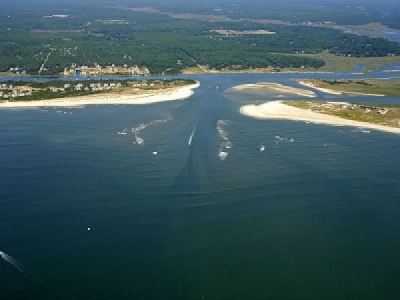
Posted on February 13, 2018
By Terry Pope, stateportpilot.com
Dredging the Lockwood Folly Inlet channel wider and deeper might be more lasting, but it would come with a steep price tag—about $4.18-million per year.
A feasibility study presented to the Brunswick County Board of Commissioners on Monday outlined how changing what’s been done in the past to keep the channel open to navigation between Oak Island and Holden Beach might be warranted.
Ken Willson, consultant with APTIM environmental engineers, said it appears authorization could be obtained to dredge the channel to 14 feet deep and 190 feet wide under the plan. Current projects aim for a maximum 12-foot channel depth and 150-foot width.
It would qualify under the state’s shallow-draft navigation inlet dredging program with a shared cost–$2.75-million by the state and $1.38-million in local funds. Dredged sand could also be placed on area beaches to protect the strand against erosion, using the Weeks Marine dredge C.R. McCaskill.
The idea of dredging the channel deeper and wider may keep it from rapidly filling with shifting sand, which has been a problem in the past. However, the work may still just last for a year.
With the permit schedule deadlines and a rush to complete dredging before sea turtle nesting season begins, it’s something that cannot be achieved this year. It would be possible in 2019.
“I think something like this to maintain would have to be done annually,” said Willson. “It depends on what kind of storm season you come through. I think the idea of it lasting for a year is reasonable, depending on the weather. I know $4.13-million is a lot of money for anyone to spend, even with cost sharing, but you will be trying something different.”
Holden Beach officials are also exploring costs on what it would take to build a jetty or some type of more permanent structure to stabilize the inlet.
“I do like the idea of trying something different,” said District 3 commissioner Pat Sykes.
Commissioners instructed county manager Ann Hardy and staff to review the study, the estimates and report back to the board with her recommendations. Overall, commissioners were receptive to the report.
“There are so many different perspectives, so it’s something that we have to remain diligent with,” said District 2 commissioner Marty Cooke. “I fully support what you (Willson) are doing.”
Cooke said maintained dredging of the inlet is good for the environment, commercial fishermen and recreational boaters. Every dollar spent on inlet maintenance can be multiplied several times in the return of benefits to the community, he added.
Commissioners hired Coastal Planning and Engineering, which was acquired by APTIM, to study alternatives to dredging the inlet, which is maintained by the U.S. Army Corps of Engineers at a level of eight to 10 feet. However, permits can authorize projects to a depth of 12-plus-two feet, a total of 14 feet, in Lockwood Folly Inlet.
In December, the county authorized the transfer of $168,000 to the N.C. Division of Water Resources as the required local match for a project to dredge Lockwood Folly Inlet this winter. Half of that, or $84,000, will be reimbursed by the Town of Holden Beach.
The corps plans to dredge the channel 10 feet deep and 100 feet wide with work to be performed by the hopper dredge Currituck, so there will be nearshore placement of beach-quality sand for Holden Beach. The dredge is on a 14-day schedule with plans to pump 40,000 cubic yards of sand.
Widening the channel to 190 feet would require a major permit modification from the N.C. Division of Coastal Management and also trigger permit changes to increase the disposal area on Holden Beach. That can be achieved before next winter.
“The timing wasn’t going to work for this coming dredging season,” said Willson. “We knew that it wasn’t possible to obtain authorization for 2017-18, but it’s well within the possibility of the 2018-19 schedule.”
Willson said the “to-do list” includes conducting exploratory vibracores, or soil sediment tests, below the 14-foot inlet depth, to determine if the sand at that level is suitable for placement on area beaches. The county would also need to request from the state one month of relief from the dredge moratorium for work in April, submit a grant application to the state, pass a resolution from commissioners to support the project and execute a local government agreement with towns on cost-sharing formulas.
“You guys are well aware that this is a constant effort,” said Willson. “Eventually, Oak Island is working on some permits where they could get some of the sand.”
Commissioners have written a letter of support for Oak Island to the corps of engineers, requesting the town become party to the SDI-5 permit that authorizes navigation channel dredging and sand placement from shallow-draft inlets between Bogue Inlet and South Carolina state line. It would allow sharing of sand from Lockwood Folly Inlet between Oak Island and Holden Beach on an equitable basis.
Capt. Cane Faircloth, president of the Lockwood Folly Inlet Association, told commissioners Monday he has seen some very successful dredging operations in the area this past year.
“We hope you keep your foot on the gas,” said Faircloth. “We still have a ways to go. The environment is in better shape today with dredging of the Lockwood Folly. I feel we have saved some lives.”
Source: stateportpilot.com





